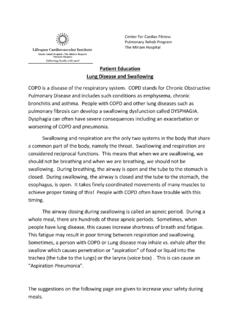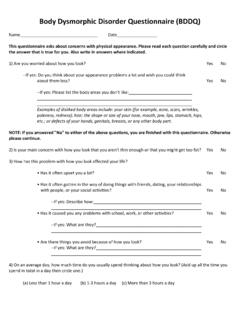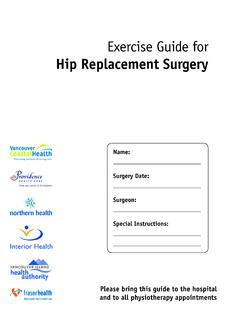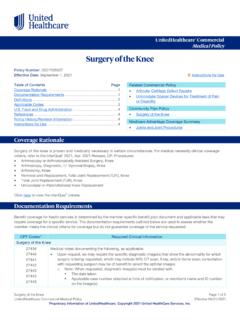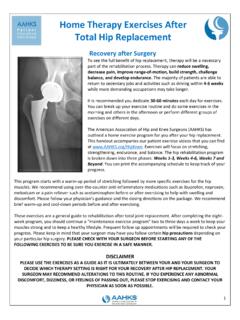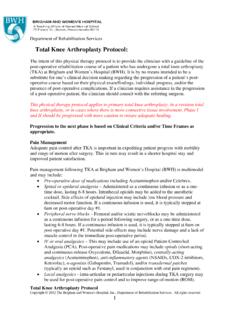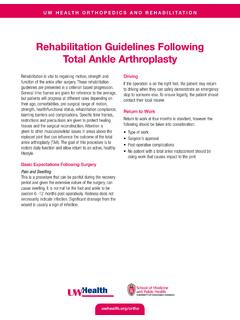Transcription of BestPractice Guideline TotalKnee Replacement(Arthroplasty)
1 Qaon National Association of Orthopaedic Nurses Advancing the Art and Science of Orthopaedic Care Best Practice Guideline total knee replacement (Arthroplasty). Editor Rebekah Filson, MS, RN, ANP-BC, ACNS-BC. Authors Candy Mori, MSN, RN, ACNS-BC, ONC. Victoria Ribsam, MSN, RN, ONC. Reviewer Lisa Holtz, MSN, RN, ONC. Additional Contributors Janine Bodden, MSN, NP-C, RN, ONP-C, RNFA. Carrie Coppola, MSN, RN-BC, ONC. Kari Erickson, RN, BAN, ONC. Tandy Gabbert, MSN, RN, ONC. Copyright 2018. National Association of Orthopaedic Nurses All rights reserved. No part of this publication may be reproduced or transmitted in any form or by any means, electronic or mechanical, including photocopy, recording, or any information storage and retrieval system without the written permission of the National Association of Orthopaedic Nurses. Published for NAON by: SmithBucklin 330 N.
2 Wabash Ave. Suite 2000. Chicago, IL 60611-4267. Toll Free: (6266). Fax: Disclaimer This Best Practice Guideline (BPG) was developed by experts in clinical practice who work in Joint Commission Disease Specific Certified environments. The BPG was guided by the NAON Executive Board with oversight from NAON's Director of Education. It is provided as an educational tool based on an assessment of current scientific and clinical research information, as well as quantifiable best practices. The tool is not intended to replace a clinician's independent judgment and critical thinking, but to enhance the clinician's knowledge regarding the care and the needs of the total joint patient throughout the continuum of care. Levels of Evidence The evidence within this best practice Guideline is rated to differentiate evidence of varying strengths and quality. The underlying assumption is that recommendations from strong evidence of high quality would be more likely to represent best practices than evidence of lower strength and less quality (Newhouse, 2007, p.)
3 90). Refer to the Appendix for an explanation of the levels of evidence contained within this Guideline . NAON Best Practice Guideline : total knee replacement Page 2 of 39. Table of Contents Introduction .. 5. Purpose .. 5. Rationale for 5. Goal of Best Practice Guideline .. 5. Description .. 5. Definition of the 6. 6. Continuum of 6. Preoperative Care .. 6. Preoperative Patient Optimization ..6. Nutrition Joint Coach (Care Partner) Selection ..10. Planning for Postoperative Mandatory Preoperative Education ..10. Blood Transfusions Prevention ..12. "PreHab" ..12. Pain Management Plan before Surgery ..13. VTE Prophylaxis Preoperative Surgical Skin and Nares Preparation ..15. Skin Antisepsis ..16. Intraoperative Care .. 16. Skin Antisepsis ..16. Anesthesia ..16. Antibiotic Prophylaxis ..18. SCD and/or Compression Traffic Patterns ..19. Maintain Normothermia to Avoid Hypothermia.
4 19. Postoperative 19. Multimodal Pain Management Plan ..19. Postoperative Incisional Care ..22. Rapid Recovery and Early Mobility ..22. Urinary Catheter and Hemovac Removal ..23. Drain Constipation Prevention ..24. Prevention of Readmissions ..24. Utilization of Clinical Quality Indicators .. 26. What Does the Future Hold for total Hip/ knee Replacements? .. 26. Becoming Joint Commission Disease Specific Certified .. 27. NAON Best Practice Guideline : total knee replacement Page 3 of 39. Web Sites .. 27. Professionals:.. 27. Patient and Family: .. 27. 29. Appendix: System for Rating the Strength of 39. System for Rating the Strength of Evidence .. 39. Level I ..39. Level II ..39. Level III ..39. Level IV ..39. Level V ..39. Level VI ..39. NAON Best Practice Guideline : total knee replacement Page 4 of 39. Introduction In 2010, Kremers et al. (2015) found the prevalence of total knee replacements in the was , corresponding to million individuals.
5 By 2030, total knee replacements are projected to grow by 673%. compared with 2005 (Kurtz, Ong, Lau, Mowat, & Halpern, 2007). These increasing demands for total knee replacements are fueled by aging baby boomers, joint injuries, and physically active life styles (Wilson, Schneller, Montgomery, & Bozic, 2008). Overall, total hip and total knee revisions are projected to grow by 137% and 601%, respectively, between 2005 and 2030. By 2040, an estimated 78 million, or 26% of United States adults ages 18 years or older, are projected to have doctor diagnosed arthritis (Hootman, Helmick, Barbour, Theis, & Boring, 2016). Around seven million Americans are living with a hip or knee replacement (Kremers et al., 2015) and that number is growing every year. The Centers for Medicare and Medicaid (CMS, 2015) estimates greater than $7 billion in hospitalization costs for inpatient total joint arthroplasties.
6 Purpose The purpose of the Best Practice Guideline for total knee replacement is to collate the current available literature to provide best practice information aimed at the continuum of nursing care for the patient undergoing a total knee replacement . This Guideline will focus on standardizing and improving patient care pathways for total knee replacement . Rationale for Guideline The rationale for the Guideline is to emphasize the importance of identifying standardized practice guidelines for the total knee replacement patient. Standardized guidelines have been shown to have a positive impact with patient outcomes. Goal of Best Practice Guideline The Guideline offers an assessment of the benefits and harms of various care and practice options for the total knee replacement patient. This will assist and empower nurses to manage the acute care requirements of the total knee replacement patient effectively.
7 The overarching goal of the Best Practice Guideline is to improve patient outcomes through the dissemination of relevant literature and proven best practices. Ultimately, adoption of recommended practices offer the potential for an enhanced patient experience and recovery. Description A total knee replacement , also known as knee replacement or arthroplasty, is a modern surgical procedure described as knee resurfacing (American Academy of Orthopaedic Surgeons [AAOS], 2015a). This surgery involves removing the diseased or damaged knee joint and repairing the weight-bearing joint with a metal/plastic or ceramic prosthetic. NAON Best Practice Guideline : total knee replacement Page 5 of 39. Definition of the Problem Due to the aging population and longer life expectancies, Go et al. (2013) found that the growing total joint replacement population has become as prevalent as several chronic diseases: stroke ( million), myocardial infarction ( million), and heart failure ( million).
8 These disease states have been heavily researched;. however, total knee replacement has not. With the growing number of total knee replacements being performed, the health care community recognizes the need for standardization of evidence based guidelines on acute and chronic care of individuals with knee replacements. There is an increasing awareness of the need to develop effective models of care that facilitate acute care management and patient self-management. Research regarding the care of the total knee replacement needs to increase and expand. Pathophysiology The most common cause for the need of a knee replacement is arthritis: osteoarthritis, rheumatoid arthritis, or posttraumatic arthritis (AAOS, 2015a): Osteoarthritis is the most common form of arthritis (Centers for Disease Control and Prevention [CDC], 2015). The pathology of osteoarthritis includes radiographic changes such as joint space narrowing, osteophytes and bony sclerosis.
9 Osteoarthritis can be described as progressive loss of hyaline cartilage. Rheumatoid arthritis is the most common autoimmune inflammatory arthritis (Singh et al., 2015). Rheumatoid arthritis is a systemic inflammatory disease that can affect multiple joints (Aggarwal et al., 2015). The pathogenesis of rheumatoid arthritis includes fibrosis, synovial cell proliferation, pannus formation and erosion of bone and cartilage. The inflammatory response manifests in the synovial membrane of joints causing hypertrophy and chronic joint inflammation. The overgrowth of the synovial cells and activation of endothelial cells then leads to erosions of the cartilage and bones. Posttraumatic arthritis is caused by a physical injury such as vehicle accident, fall, dislocation, or any source of blunt trauma (Lotz, 2010). These injuries damage the articular cartilage and the bone, changing the mechanics of the joint and accelerating the progression toward osteoarthritis.
10 The pathogenesis of posttraumatic arthritis occurs with the injury and progresses over time. Initially there is cell necrosis, collagen rupture and hemarthrosis. Months later, there is apoptosis, leukocyte infiltration, and extracellular matrix degradation. Over the years, the joint tissue will remodel and chronic inflammation will be present. Continuum of Care Preoperative Care Preoperative Patient Optimization Organizations and programs that seek evidence-based approaches to enhance patient outcomes typically address preoperative optimization to include one or more of these areas: NAON Best Practice Guideline : total knee replacement Page 6 of 39. 1. Dental Issues 2. Sleep Apnea 3. Smoking 4. BMI. 5. Anemia 6. Hypertension 7. Hyperglycemia 8. Nutrition/low albumin 9. Alcohol/Drug consumption 10. Catastrophizing (considered a serious risk on outcomes and should be potential grounds for cancellation or delay of surgery.)


